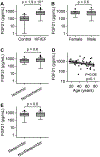FGF21 (Fibroblast Growth Factor 21) Defines a Potential Cardiohepatic Signaling Circuit in End-Stage Heart Failure
- PMID: 34865514
- PMCID: PMC8930477
- DOI: 10.1161/CIRCHEARTFAILURE.121.008910
FGF21 (Fibroblast Growth Factor 21) Defines a Potential Cardiohepatic Signaling Circuit in End-Stage Heart Failure
Abstract
Background: Extrinsic control of cardiomyocyte metabolism is poorly understood in heart failure (HF). FGF21 (Fibroblast growth factor 21), a hormonal regulator of metabolism produced mainly in the liver and adipose tissue, is a prime candidate for such signaling.
Methods: To investigate this further, we examined blood and tissue obtained from human subjects with end-stage HF with reduced ejection fraction at the time of left ventricular assist device implantation and correlated serum FGF21 levels with cardiac gene expression, immunohistochemistry, and clinical parameters.
Results: Circulating FGF21 levels were substantially elevated in HF with reduced ejection fraction, compared with healthy subjects (HF with reduced ejection fraction: 834.4 [95% CI, 628.4-1040.3] pg/mL, n=40; controls: 146.0 [86.3-205.7] pg/mL, n=20, P=1.9×10-5). There was clear FGF21 staining in diseased cardiomyocytes, and circulating FGF21 levels negatively correlated with the expression of cardiac genes involved in ketone metabolism, consistent with cardiac FGF21 signaling. FGF21 gene expression was very low in failing and nonfailing hearts, suggesting extracardiac production of the circulating hormone. Circulating FGF21 levels were correlated with BNP (B-type natriuretic peptide) and total bilirubin, markers of chronic cardiac and hepatic congestion.
Conclusions: Circulating FGF21 levels are elevated in HF with reduced ejection fraction and appear to bind to the heart. The liver is likely the main extracardiac source. This supports a model of hepatic FGF21 communication to diseased cardiomyocytes, defining a potential cardiohepatic signaling circuit in human HF.
Keywords: bilirubin; fibroblast growth factor; ketones; metabolism; natriuretic peptides.
Figures




References
-
- Cluntun AA, Badolia R, Lettlova S, Parnell KM, Shankar TS, Diakos NA, Olson KA, Taleb I, Tatum SM, Berg JA, Cunningham CN, Van Ry T, Bott AJ, Krokidi AT, Fogarty S, Skedros S, Swiatek WI, Yu X, Luo B, Merx S, Navankasattusas S, Cox JE, Ducker GS, Holland WL, McKellar SH, Rutter J and Drakos SG. The pyruvate-lactate axis modulates cardiac hypertrophy and heart failure. Cell Metab. 2021; 33:629–648.e10. - PMC - PubMed
-
- Badolia R, Ramadurai DKA, Abel ED, Ferrin P, Taleb I, Shankar TS, Krokidi AT, Navankasattusas S, McKellar SH, Yin M, Kfoury AG, Wever-Pinzon O, Fang JC, Selzman CH, Chaudhuri D, Rutter J and Drakos SG. The Role of Nonglycolytic Glucose Metabolism in Myocardial Recovery Upon Mechanical Unloading and Circulatory Support in Chronic Heart Failure. Circulation. 2020; 142:259–274. - PMC - PubMed
-
- Diakos NA, Navankasattusas S, Abel ED, Rutter J, McCreath L, Ferrin P, McKellar SH, Miller DV, Park SY, Richardson RS, Deberardinis R, Cox JE, Kfoury AG, Selzman CH, Stehlik J, Fang JC, Li DY and Drakos SG. Evidence of Glycolysis Up-Regulation and Pyruvate Mitochondrial Oxidation Mismatch During Mechanical Unloading of the Failing Human Heart: Implications for Cardiac Reloading and Conditioning. JACC Basic Transl Sci. 2016; 1:432–444. - PMC - PubMed
Publication types
MeSH terms
Substances
Grants and funding
LinkOut - more resources
Full Text Sources
Medical
Research Materials
Miscellaneous

